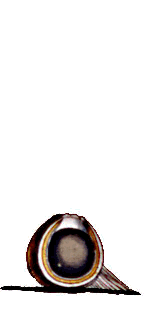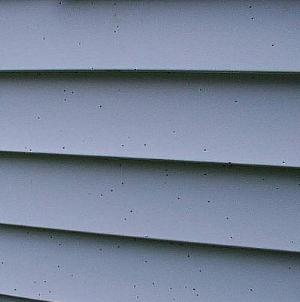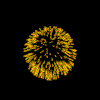--by Lawrence Leonard and Tom Volk
Please click TomVolkFungi.net for the rest of Tom Volk's pages on fungi

In honor of the fireworks on the Fourth of July, we present Sphaerobolus stellatus, the cannonball fungus. The "cannonball fungus" or "sphere thrower" is a powerful little fungus which was known to science since Micheli's description in 1729, and is certainly well-known to people today whose cars or houses are peppered by globs of reddish-black stuff ejected by this fungus. A well known mycologist, Buller, years ago described mushroom hunters sitting on a log and hearing popping sounds: the cannonball fungus firing its load! (Hearing must have been better back in the 1800's.)
Buller notes "….the catapult mechanism of great beauty and efficiency." He found an increase in the size of the cells in one of the layers of the everting membrane pre and post discharge and felt this was due to increased "turgescence" due to increased osmotic pressure from the conversion of glycogen to sugars prior to discharge. Dykstra summarized his work noting the mechanism was felt to be "some sort of osmotic process" however with electron microscopy he found no change in the cell size and shape of the two everting layers.
Buller years later carefully recorded "Olympic records" for this 1/8 inch fungus, and he found that the spore mass could be shot as far as 18 feet in distance, attaining a height of 14 feet! For a 6 foot tall person to accomplish the same relative feat (if you do the math...), he would have to throw a baseball nearly 1.5 miles high, and the ball would fall almost 2 miles away!
The name Sphaerobolus stellatus is itself very descriptive. Sphaerobolus means "sphere thrower," referring to the spore mass that is forcibly shot out, and stellatus refers to the star shaped structure that's left after the spore mass has been ejected.
Where does Sphaerobolus fit in the fungal classification scheme? It is a basidiomycete like Amanitas, Russulas, and Chanterelles, but these fungi are Hymenomycetes, which means that their basidiospores (the sexual spores of a basidiomycete) are forcefully ejected from each basidium (the cell where the spore is produced).
Sphaerobolus is in a different (albeit artificial) class, the Gasteromycetes, along with puffballs (such as Lycoperdon and Calvatia), earthballs, such as Pisolithus tinctorius (the dog turd fungus), earth stars, and stinkhorns. In this class the spore is not actually forcefully discharged from its basidium. Microscopically you can tell this gasteromycete spore from an Amanita or Russula ballistospore (a spore which is forcefully discharged from its basidium) because the ballistospore has an asymmetrical sterigma (tiny filament from the basidium to the spore) attachment at its base. The gasteromycete sterigma attachment is either central or there are no sterigmata with the spore directly attached to the basidium. So, how does the gasteromycete spore get out into the world? Puffballs and earthballs break open and the wind blows the spores around. Earth stars unfold and the spores are dispersed by outside forces through a small pore. Stinkhorn smell bad, which attracts flies and beetles that spread the spores around.Sphaerobolus blasts its mass of thousands of tiny spores and gemmae out as a sticky spore mass called a gleba. But, although the mass of spores is forcefully ejected, the mechanism clearly is not of the basidium ejecting its individual spores as in the Hymenomycetes.
We hope you enjoyed learning about the cannonball fungus. Its reproductive structures and their activities are amazing, even in the weird world of fungi. Take a closer look at your mulch, and see if you can find this tiny marvel. Or maybe you can find it on your siding?
Learn more about fungi! Go to Tom Volk's Fungi Home Page --TomVolkFungi.net
Return to Tom Volk's Fungus of the month pages listing
 As you might guess, the cannonball fungus can actually propel its "cannonball" with quite a large force for quite a long distance. Of course the purpose of shooting out the cannonball (really an egg-shaped peridiole with a mass of spores inside) is to disperse the spores of the fungus away from the parent and to a new substrate.
As you might guess, the cannonball fungus can actually propel its "cannonball" with quite a large force for quite a long distance. Of course the purpose of shooting out the cannonball (really an egg-shaped peridiole with a mass of spores inside) is to disperse the spores of the fungus away from the parent and to a new substrate.
 So what happens after the spore mass is ejected? They germinate: Buller notes the sticky glebal mass contains spores (6-8 X 4-5 um) and gemmae which are larger than the spores and are "peculiar oval or oval-elongated cells." He and others found that the gemmae germinate easily with germ tubes sprouting from them with clamp connections (a microscopic characteristic frequently, but not always, found in basidiomycetes.) Dykstra, 1982, in his cytological examination of Sphaerobolus, also noted that the gemmae germinated but the spores did not. The gemmae were larger than the spores and were thin-walled. Spores are difficult to germinate under laboratory conditions. Buller observed that a trace of the enzyme pepsin did help some germinate, noting "This is a very significant fact in connection with the dispersion of the fungus by herbivorous animals…." The glebal masses kept dry for 11 years have been found to germinate. Dykstra examined the sticky outer wall with electron microscopy and noted it was "amorphous…material" coming from degraded cells. Buller noted the glebal mass "never becomes brittle, even when dried…..the strongest winds cannot break it into pieces" and rain did not dissolve it. But it apparently is broken down in the gut of herbivores! So, when the an animal eats some greenery with the glebal masses of gemmae and spores by the time it is redeposited out in Mother Nature it is ready to germinate!
So what happens after the spore mass is ejected? They germinate: Buller notes the sticky glebal mass contains spores (6-8 X 4-5 um) and gemmae which are larger than the spores and are "peculiar oval or oval-elongated cells." He and others found that the gemmae germinate easily with germ tubes sprouting from them with clamp connections (a microscopic characteristic frequently, but not always, found in basidiomycetes.) Dykstra, 1982, in his cytological examination of Sphaerobolus, also noted that the gemmae germinated but the spores did not. The gemmae were larger than the spores and were thin-walled. Spores are difficult to germinate under laboratory conditions. Buller observed that a trace of the enzyme pepsin did help some germinate, noting "This is a very significant fact in connection with the dispersion of the fungus by herbivorous animals…." The glebal masses kept dry for 11 years have been found to germinate. Dykstra examined the sticky outer wall with electron microscopy and noted it was "amorphous…material" coming from degraded cells. Buller noted the glebal mass "never becomes brittle, even when dried…..the strongest winds cannot break it into pieces" and rain did not dissolve it. But it apparently is broken down in the gut of herbivores! So, when the an animal eats some greenery with the glebal masses of gemmae and spores by the time it is redeposited out in Mother Nature it is ready to germinate!
 So, Sphaerobolus is a very cool fungus in its reproduction, but can it affect people's everyday lives? Not surprisingly, the answer is yes! Sphaerobolus likes to grow on wood mulch, where there's plenty of food (i.e. the wood) and moisture. If the mulch is next to the house or garage, the spore mass may be shot directly at the structure. If it hits the siding on the house it will stick very tight, using the natural "glue" that covers the spore mass. If your house is made of wood, the spores can germinate (if there's enough water), and the resulting mycelium can grow into the wood. If you have aluminum or vinyl siding, the spores can't do any harm, although some people find them unsightly. Unfortunately, like other fungi that grow in mulch, such as Fuligo septica, the dog vomit slime mold and Dictyophora duplicata and other stinkhorns, most of these fungi are near impossible to get rid of without completely replacing the mulch and paving over the yard. I recommend you read more of my pages and find some way to enjoy the fungi in your yard. Show them off to your friends. Cultivate a fungus garden. Wouldn't it be nice to be able to show off something unusual in your yard? In any case, when the nutrition in the mulch has been used up by the fungi, they'll stop growing and reproducing. Unfortunately if you add more mulch of the same kind, you're likely to just encourage growth of your fungus on the new mulch. If you're using hardwood mulch, it might help to add conifer mulch and vice versa. I have not tested this, but it makes sense theoretically, at least for some fungi. If you try this let me know how it worked for you.
So, Sphaerobolus is a very cool fungus in its reproduction, but can it affect people's everyday lives? Not surprisingly, the answer is yes! Sphaerobolus likes to grow on wood mulch, where there's plenty of food (i.e. the wood) and moisture. If the mulch is next to the house or garage, the spore mass may be shot directly at the structure. If it hits the siding on the house it will stick very tight, using the natural "glue" that covers the spore mass. If your house is made of wood, the spores can germinate (if there's enough water), and the resulting mycelium can grow into the wood. If you have aluminum or vinyl siding, the spores can't do any harm, although some people find them unsightly. Unfortunately, like other fungi that grow in mulch, such as Fuligo septica, the dog vomit slime mold and Dictyophora duplicata and other stinkhorns, most of these fungi are near impossible to get rid of without completely replacing the mulch and paving over the yard. I recommend you read more of my pages and find some way to enjoy the fungi in your yard. Show them off to your friends. Cultivate a fungus garden. Wouldn't it be nice to be able to show off something unusual in your yard? In any case, when the nutrition in the mulch has been used up by the fungi, they'll stop growing and reproducing. Unfortunately if you add more mulch of the same kind, you're likely to just encourage growth of your fungus on the new mulch. If you're using hardwood mulch, it might help to add conifer mulch and vice versa. I have not tested this, but it makes sense theoretically, at least for some fungi. If you try this let me know how it worked for you.
 This month's co-author is Dr. Laurie Leonard, a retired physician and very dedicated non-professional mycologist who lives on the coast of Maine. He's shown here with his wife Marcia at Eagle Hill in Maine, where I taught a field class on basidiomycetes in 2000.
This month's co-author is Dr. Laurie Leonard, a retired physician and very dedicated non-professional mycologist who lives on the coast of Maine. He's shown here with his wife Marcia at Eagle Hill in Maine, where I taught a field class on basidiomycetes in 2000.
If you have anything to add, or if you have corrections, comments, or recommendations for future FotM's (or maybe you'd like to be co-author of a FotM?), please write to me at volk.thom@uwlax.edu
This page and other pages are © Copyright 2005 by Thomas J. Volk, University of Wisconsin-La Crosse.

 Tom Volk's Fungus of the Month for July 2005
Tom Volk's Fungus of the Month for July 2005